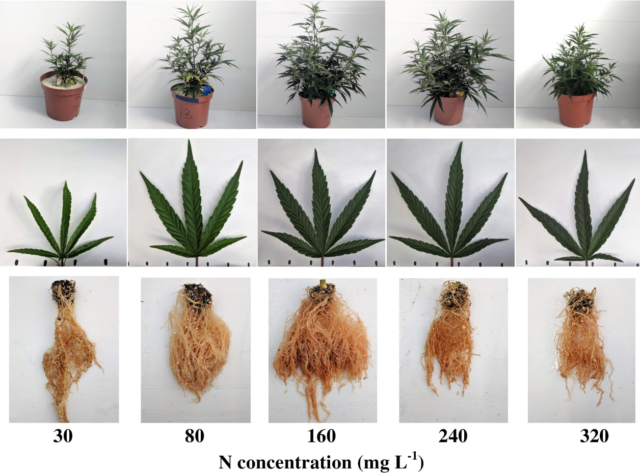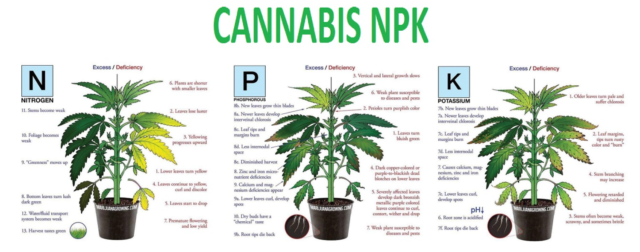Are you a cannabis grower looking for the best way to ensure your plants will thrive? If so, then this content is for you! Here you’ll find an overview of the guidelines for organic nutrients that can help your cannabis plants reach their full potential. Read on to learn more!
Types Of Fertilizers
Types of fertilizer cannabis are essential in providing the best nutes for outdoor grow with the necessary nutrients to grow. There are two main fertilizers: synthetic chemical fertilizer and organic fertilizer. Synthetic fertilizer is a commercially available type of fertilizer that contains highly concentrated levels of the three primary nutrients: nitrogen, phosphorus, and potassium.
Natural organic fertilizer sources include animal waste, vegetable waste, and glacial sediments. Organic fertilizers are also known to contain secondary macronutrients and micronutrients, which are beneficial for a cannabis plant’s growth. The optimal rate of NPK fertilizer use for cannabis plants should be between 2/3/4 and 200 mg L–1. Additionally, growers should observe the difference between fertilizers and supplements during the veg and Cannabis Flowering Stages for optimal results.
Synthetic Chemical Fertilizer
Synthetic chemical fertilizers are designed for Cannabis cultivation and are made with precise NPK ratios and micro and macronutrients for each growth stage. These fertilizers contain essential nutrients such as nitrogen, phosphorus, and potassium as well as secondary macronutrients and micronutrients such as calcium deficiency cannabis, boron, cannabis zinc deficiency and iron. The inefficiency of synthetic fertilizers can be alleviated by applying plant growth-promoting microbes (PGPM), ensuring optimal N supply to plants grown with liquid organic fertilizers.

Organic Fertilizer
Organic fertilizer is an effective and natural way to provide nutrients for cannabis plants. It comprises organic materials such as manure, compost, and biofertilizers capable of slowly releasing nutrient deficiency chart ions into the soil. Soil amendments and organic fertilizers should be well-rounded. Organic fertilizers provide the primary nutrients of nitrogen, phosphorus, and potassium (NPK) and secondary macronutrients and micronutrients, which are essential for the plant deficiency chart. Understanding the basics of NPK numbers and how to read them will help you determine the best fertilizer for your cannabis nutrient kit.
Furthermore, different nutrients are needed during the vegetative and flowering stages, so it is essential to know when to start feeding your plants with the appropriate nutrients. Lastly, using fertilizers every time you water your plants is unnecessary, as some supplements can be used with fertilizers for better results.
Organic VS Synthetic Fertilizers
Organic and synthetic fertilizers are two approaches to providing nutrients to cannabis plants. This contains moderate nutrients that support plant growth and have low nitrogen, phosphorus, and other minerals. On the other hand, synthetic fertilizers generally list all their nutrients on the label. Many organic fertilizers contain multiple plant nutrients and may not list them all, while inorganic fertilizers do well in both hydroponic environments and soil.
While organic farming tends to rely on tillage for Weed Measurements, and conventional agriculture depends on the heavy use of synthetic nitrogen fertilizers, the integration of concentrated organic manures with chemical fertilizer effectively inhibits weed growth and nutrient removal. Thus, understanding the differences between organic and synthetic fertilizers can help cannabis plants get the necessary nutrients.
Micronutrients and Macronutrients for Cannabis Plants
The micronutrients and nutrients for cannabis plants are essential for optimal growth and development. The three primary macronutrients, nitrogen (N), phosphorus (P), and potassium (K), are required in larger quantities than other nutrients. Additionally, secondary nutrients such as calcium (Ca), sulfur (S) and magnesium (Mg) are also crucial for healthy plant growth. Synthetic and organic chemical fertilizers can provide the necessary nutrients in the correct ratios. A leaf deficiency chart is essential to understand how to read fertilizer numbers and the difference between cannabis fertilizers and supplements. By providing the right amount of NPK fertilizer during the vegetative and flower stages, growers can successfully harvest weed nutrients kit.

What is NPK?
The three primary nutrients for cannabis plants are nitrogen (N), phosphorus (P), and potassium (K). These three nutrients, the NPK ratio, are essential for healthy growth and development. Nitrogen is vital for vegetative growth and photosynthesis, phosphorus helps with root development and flower production, and potassium is necessary for overall plant health. Together, they create a balanced nutrient profile that can help maximize your cannabis crop’s potential.

Secondary Macronutrients And Micronutrients
In addition to the essential macronutrients, secondary macronutrients such as calcium, magnesium, and sulfur are also needed for optimal cannabis growth. Micronutrients such as iron and copper are required in much smaller amounts. Each of these nutrients helps cannabis plants develop strong roots and stems, produce high-quality CBD flowers, and achieve maximum yields. To effectively meet a cannabis plant’s nutrient needs, each nutrient must be understood and provided in the right amounts.
How To Read Fertilizer Numbers
Understanding the numbers on fertilizer labels is essential for getting the right balance of nutrients for your cannabis marketing businesses. Every fertilizer has three numbers on the label, representing the primary nutrients nitrogen (N), phosphorus (P), and potassium (K). It is essential to know what these numbers stand for and how their balance affects plant growth. The first number is always nitrogen (N), the second is phosphorus (P), and the third is potassium (K). This “N-P-K” ratio reflects the available amounts of these essential plant nutrients.
Many types of fertilizers, both synthetic chemical and organic, can be used to supplement the soil with these nutrients. In addition to the primary nutrients, micronutrients and macronutrients can also be added to your soil to help promote healthy plant growth. Knowing how to read fertilizer labels and understand each nutrient’s role will help ensure your cannabis feed schedule gets all they need for optimal development.
NPK Fertilizer
NPK Fertilizers are the most popular type of fertilizer for nutrient cannabis which provide the three primary macronutrients; nitrogen (N), phosphorous (P), and potassium (K). NPK fertilizers come in a variety of forms, including synthetic chemical fertilizers as well as organic fertilizers. Synthetic chemical fertilizers can give cannabis plants a quick boost of nutrients, while organic fertilizers provide a slow release of canna deficiency chart. It’s essential to understand the differences between synthetic and organic fertilizers and to read the fertilizer numbers on the label, so you know how much of each nutrient your plants are getting. Additionally, secondary macronutrients and micronutrients should be considered when providing nutrients to organic cannabis nutrients.
Difference Between Cannabis Fertilizers And Supplements
The difference between cannabis fertilizers and supplements lies in their composition and purpose. Fertilizers are primary nutrients such as nitrogen (N), phosphorus (P), and potassium (K) that are essential for the growth of cannabis plants. On the other hand, organic fertilizers are derived from organic sources such as animal or vegetable waste and contain secondary macronutrients and micronutrients. On the other hand, supplements are composed of vitamins, amino acids, seaweed or plant extracts, and humic or/and fulvic acids to stimulate plant growth and increase yields. While fertilizers provide nutrients that cannabis plants need to grow, supplements offer additional benefits like higher yields, improved resistance to pests, flowering stage optimization and much more.
Nutrients For Veg Stage
The vegetative stage is the most important for cannabis plants, so providing them with the proper nutrients is essential. Organic fertilizers can be a great option, as they provide macronutrients like nitrogen, phosphorus and potassium, as well as micronutrients like calcium and magnesium. Research published in cannabis clones found that organic fertilizer applied at a rate of 1.7K to container-grown cannabis plants with coir-based organic substrates produced positive results. This study aimed to define the optimal engagement of N, P, and K in the nutrient resolution for the flowering stage of soilless cannabis. So, when it comes to feeding your cannabis plants during the vegetative stage, organic fertilizers are a great choice to ensure your plants get all the necessary nutrients for optimal growth and health.
Nutrients During The Flowering Stage
The flowering stage requires a different set of nutrients than the vegetative stage. During this period, your plants need higher levels of phosphorus and potassium and all of the essential micronutrients. These nutrients will help your plants develop larger and denser flowers, leading to higher yields. A good rule of thumb is to switch to bloom nutrients around the sixth or seventh week of the flowering stage and fertilize your plants about every two weeks.
FAQ
Growing marijuana is an exciting prospect, but it can also be a daunting task. However, with the proper knowledge and resources, you can cultivate a bumper crop of healthy best nutrients for cannabis plants. It is vital to comprehend the fundamentals of organic fertilizers and nutrient management for cannabis. This includes understanding the difference between synthetic and organic fertilizers, the significance of NPK levels, and the importance of micronutrients and secondary macronutrients.

Additionally, you should know how to read fertilizer numbers to determine the right nutrient balance for your nutrients for weed plants. When it comes to cannabis fertilizers and supplements, you should also be aware of their differences and how they should be used in each growth stage. Finally, questions such as when you should start feeding your plants with nutrients and whether you should use them every time you water will help canna deficiency guide your growing journey.
When Should I Start Feeding My Plants With Nutrients?
When it comes to feeding your plants, you should wait until they’re about 3–4 weeks old and have developed 3–4 true leaves before introducing liquid nutrients. To ensure healthy growth, you should feed them average amounts of nutrients once they’re a week or two old, depending on their size. Additionally, outdoor cannabis growers typically add powdered nutrients to the soil when transplanting a weed plant outside.
This will give your plants the essential NPK they need during their 12–13 week growing cycle. NPK stands for nitrogen, phosphorus, and potassium and is the three primary fertilizer components necessary for healthy plant growth. With this in mind, it’s essential to understand the difference between fertilizers and supplements as well as how to read fertilizer numbers correctly to meet your cannabis plants’ nutritional needs accurately.
Should I Use Nutrients Every Time I Water?
While there is no definitive answer regarding how often you should use nutrients, it is crucial to understand that cannabis plants need certain essential nutrients to grow and remain healthy. Liquid nutrients (and PK boosters) are sometimes added in each watering or can be used alternatively with water or base nutrients.
If you are using a synthetic chemical fertilizer, you may need to apply it every other watering. You will likely need to fertilize with organic fertilizers every two weeks. It’s important to understand that different plants require different amounts of nutrients, so always read the instructions on the label and follow the manufacturer’s recommendations.




